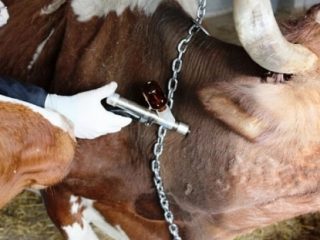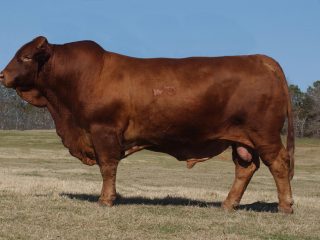Content
The situation when a cow falls on her feet and cannot get up often occurs when keeping cattle and invariably plunges the animal owner into panic. And there is a reason. Cattle are less adapted to living in a lying position than horses or elephants. But cows are also large “animals”. When lying down for a long time, body weight puts pressure on the internal organs. As a result, emphysema and pathologies of the kidneys, liver and gastrointestinal tract develop. If the animal is not raised quickly, it dies. There are not many reasons why a cow falls on her feet, and most of them are related to impaired metabolism.
Why doesn't the cow get up on her feet?
The anatomy of cattle is such that when rising from a lying position, they first straighten their hind legs and only then their front legs. If the animal cannot lift its hindquarters, it remains lying down. Usually, when a cow's hind legs fail, the owners first assume postpartum paresis. In most cases they are right, but sometimes a cow can fall on her feet long before calving or several months after it. Sometimes even in young bulls taken for fattening, the legs begin to fail. There is no way to attribute this to calving.
In addition to metabolic paresis, the most common reason is that cows begin to have problems with the musculoskeletal system. An animal can fall on its feet as a result of the development of:
- hypovitaminosis E
- lack of selenium;
- white muscle disease;
- lack of phosphorus;
- ketosis;
- rickets;
- arthritis.
In poor conditions, many cows may fall on their feet due to joint inflammation or hoof problems. If the imbalance of the diet does not always depend on the owner, then the maintenance is entirely on his conscience.
With metabolic disorders, the lack of one element causes a chain reaction in the body. A cow cannot fall on her feet simply due to vitamin E deficiency or selenium deficiency. But this entails the development of white muscle disease, as a result of which the animals’ muscles refuse to work.
If a calf develops rickets due to a lack of vitamin D, then an adult cow develops osteomalacia. The latter can also only be a symptom of hypophosphatasia, a genetic disease.
Cows give off a lot of calcium through their milk. She “takes” it from her own bones. Even if the owner tries to replenish this element to his nurse, the calcium content still decreases with age. A lack of metal in the bones leads to changes. And a sign of age-related calcium deficiency is that the cow begins to have difficulty standing on her hind legs. Over time, the problem worsens, and the animal can no longer stand at all.
Among the more exotic reasons why a cow does not stand on her hind legs is the pressure of the fetus on the nerves in the sacrum.During deep pregnancy, the fetus in the uterus can press on the rump of a lying cow from the inside.
Calves may collapse if suddenly switched from a dairy diet to roughage. In this case, the book becomes clogged with grain, and sometimes with soil, when the animal tries to eat grass. This often happens in bulls taken for fattening, which are purchased at 2-3 months of age. Since their gastrointestinal tract is not yet developed, the calf is not able to digest grain. A clogged book causes pain and a desire to lie down. Then the cub weakens and dies.
The most rare case of foot problems in cows is unkempt hooves. Even city dwellers almost all know that horses need to be shoed and their hooves taken care of. But for cows and small livestock this moment is very poorly covered. However, their hooves also need to be looked after. Cows also need to be trimmed every 3 months. Otherwise, the overgrown hoof wall may curl inward and begin to put pressure on the sole. If a stone gets between them, it will cause a lameness very similar in appearance to osteomalacia. Since being napped is very painful, the cow gets to her feet poorly and reluctantly, preferring to lie down.

Sometimes the reason a cow falls on its feet is due to neglect of hoof care.
White muscle disease
This is a metabolic disease that affects young animals up to 3 months old. It occurs as a result of a lack of a whole complex of elements, but the leading link is a deficiency of vitamin E and selenium. The disease develops gradually, and lifetime diagnosis is always presumptive.
Since the calf weakens slowly, the owner may not pay attention to the animal's discomfort. The owner comes to his senses only after the young animals have already fallen to their feet. At this stage, treatment is useless and the calves are sent to slaughter.
In the early stages of the disease, animals are provided with high-quality feed with plenty of vitamins, and injections of the missing elements are carried out.
Vitamin E is prescribed intramuscularly. Course 4 days 1-2 times a day. For the next 5 days, inject every other day at a rate of 3-5 mg/kg body weight. Then - once a week at the same dose as the previous course.
Phosphorus deficiency
A cow may fall on its feet if there is a lack of phosphorus. But the element itself will not be “to blame” for this. Its deficiency entails a whole chain of metabolic changes. Cattle can stand on their feet, but prefer to lie down; the joints on the limbs become enlarged. The position changes: the cow crosses her front legs.
It is difficult to correct the balance of phosphorus in feed using feed phosphates. In Russia, only two types of premixes are produced: defluorinated phosphate and monocalcium phosphate. They are not suitable for dry cows that require a low calcium to phosphorus ratio. These premixes are of little use for ruminants during other periods of life. Cattle do not have enough hydrochloric acid in their stomachs to extract phosphorus from calcium phosphates in the feed.

You can look for tricalcium phosphate produced in Kazakhstan for sale
Ketosis
To put it simply, this is protein poisoning. Caused by an excess of protein feed in the diet. In mild cases, the cow exhibits a perversion of appetite and signs of intoxication. When severe, depression sets in and animals prefer to lie down.
The owner often believes that a cow in ketosis has fallen on its feet, although it can be made to stand up.But if the disease develops after calving, then protein poisoning is often mistaken for postpartum congestion or paresis. Treatment carried out in the event of an incorrect diagnosis is expectedly unsuccessful. The definition of “fell on its feet” in this case means that the animal has not lost its hind limbs, but it is simply difficult for it to stand. And when rising from a lying position, the cow does not have normal support.
Rickets
The most well-known disease of young animals caused by a lack of vitamin D and exercise. But in order for a calf with rickets to “fall on its feet,” you have to “try hard.” Usually, with this disease, young animals are stunted in growth, and also develop a barrel-shaped chest and crooked limbs.
With rickets, not only the bones soften, but also the ligaments. As a result, the fetlock joints often “sag” very much: on the hind limbs they “sink”, and on the front limbs the picture looks like contracture.

Lack of phosphorus, or more precisely, its incorrect ratio with calcium, is the main cause of the development of bone diseases
Osteomalacia
In part, it can be called the “adult” version of rickets. It also develops with a lack of vitamin D and insufficient exercise. But cows have another reason for the development of this pathology: milk. Dairy cattle release too much calcium from their bones.
With osteomalacia, bone volume increases but bone density decreases. Bone tissue becomes soft. The first sign of calcium leaching is softening of the tail vertebrae. Ligaments also lose their shape. Gradually, it becomes difficult for the cow to stand and move. Similar signs are observed in older animals, even those with a nutritious diet and good living conditions. Especially among high-yielding ones.
If an older cow falls on her feet, veterinarians usually advise giving her up for meat and not suffering. The average lifespan of dairy cattle is 8 years. This is the price for large milk yields.
The process can only be slowed down. This is why there is no point in trying to raise an old cow.
How to raise a cow to its feet
Here you will first have to clarify what is meant by the word “raise.” Usually cows are not lifted, they stand up on their own. After receiving intravenous injections of the necessary drugs. This practice is common in postpartum paresis.
If the cow falls on her feet due to prolonged metabolic changes, she is “suspended.” The measure is very controversial and temporary. In handicraft conditions, it is very difficult to make a machine for hanging such a large animal. The cloth, even a wide one, puts pressure on the chest, since the cow does not stand, but hangs. The harness can be used for 1-2 days or to transport a cow whose legs have given out in the pasture. But if the animal does not recover within a couple of days, it will have to be slaughtered. Direct treatment is carried out after diagnosis and with the use of appropriate medications.

The harness is good for transporting a cow from the field if she falls on her feet while grazing, but not for permanent housing
What to do if the bull does not get to his feet
With a high degree of probability of cutting. Most often, legs fail in bulls at the age of several months. Since complete mineral premixes are not produced in Russia, it is unlikely that it will be possible to improve the calf’s metabolism. At least, practice shows that after suffering for a week or two, the owner slaughters the bull. If he doesn't have time to fall first.
If white muscle disease is suspected, the calf is given injections of selenium and vitamin E.But a baby can lie down for other reasons. Therefore, to establish a diagnosis, you need to invite a veterinarian as soon as possible.
Veterinarian advice
If the matter does not concern postpartum paresis or congestion, veterinarians do not have any special advice. With the gradual development of muscle degradation, you need to reconsider your diet. The calf should stop feeding grain feed. An adult cow needs a balanced diet.
Sometimes it doesn’t hurt to even check the hooves and joints. Perhaps the cow is afraid to stand because of the pain. An animal can also be paralyzed if its spine is damaged. And there are no guarantees that it will be restored. However, no one can promise that he will definitely die.
If the hope of raising the animal is not yet lost, it is necessary to massage the limbs and sacrum to improve blood circulation. A lying cow is turned from side to side 2 times a day and rubbed with a jute bag or a straw rope.
Conclusion
If the cow fell on its feet not as a result of a postpartum complication, the treatment process will be long and, most likely, unsuccessful. Often, in such cases, no one can offer any methods of treatment or prevention, other than changing the feeding regime and diet and improving living conditions.








